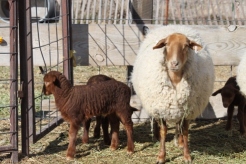California Red
 Most breeds names are a combination of their development location as well as any unique physical element, the California Red is no different. Developed in 1970 by Dr. Glenn Spurlock who hoped to breed a hair sheep that would have no wool, the California Red is born without wool, only red hair. However as it grows the sheep grows it develops an oatmeal colored wool with red hairs interspersed, that like many “hair sheep” it sheds every spring.
Most breeds names are a combination of their development location as well as any unique physical element, the California Red is no different. Developed in 1970 by Dr. Glenn Spurlock who hoped to breed a hair sheep that would have no wool, the California Red is born without wool, only red hair. However as it grows the sheep grows it develops an oatmeal colored wool with red hairs interspersed, that like many “hair sheep” it sheds every spring.

California Red’s an Irish setter color when fully grown stays solid only on their faces and limbs, redish tan hairs mixed intermingle with its wool. Today they are considered a dual purpose breed, medium size with a lean meat with a solid frame. They were a cross between Tunis and Barbados Blackbelly and have breed traits similar to both. California Reds are wonderful youth sheep as they are super clam and gentle, and handle well. They also are excellent for small home dairy operations as their milk is high in milk solids creating a larger cheese yield than average sheep milk.
California Red is not an easy fiber to find as the breed is still generally being raised as a no-shear meat breed. Furthermore, the breed is part of a national conservation project as an American Heritage breed in danger of high rates of inbreeding due to closed registry herd books, and many flocks being dissolved and sold to create hair/wool crossbreeds for market lambs.
The Fiber
While being called Red the wool is more often than not an oatmeal color with cinnamon-red hairs interspersed. The wool has moderate luster, but takes dyes well with the red hairs quickly accepting dye to create a natural tweed look when spun. The fiber has consistent crimp and loft that easily blooms when washed. The fiber has a unique feel and visual texture created
 by contrasting red hairs. The hairs are not as soft as the wool however the wool has a 22-30 micron count and a 3-6 inch staple length. Each fleece should be considered independently as there can be considerable differences in quality dependent on location, feed and processing of the fibers. California Reds in colder climate have a higher wool yield than warmer locations with an average of each sheep shearing between 4-7 pounds of clean well skirted fleece.
by contrasting red hairs. The hairs are not as soft as the wool however the wool has a 22-30 micron count and a 3-6 inch staple length. Each fleece should be considered independently as there can be considerable differences in quality dependent on location, feed and processing of the fibers. California Reds in colder climate have a higher wool yield than warmer locations with an average of each sheep shearing between 4-7 pounds of clean well skirted fleece.
I was happy to be able to sample some US grown California Red. I found spinning Mountain Meadows Wool California Red to be softer than I expected. The fibers is lofty working best with a short draw technique, leaving me when an even 2-ply fiber that bloomed. I didn’t need as much twist as I thought I would when I first squeezed the roving, but how I handled the fiber drastically changed the outcome of the yarn. This is a lovely fiber to drop spin clinging nicely to itself and allowing me to use one of my heaver spindles.
